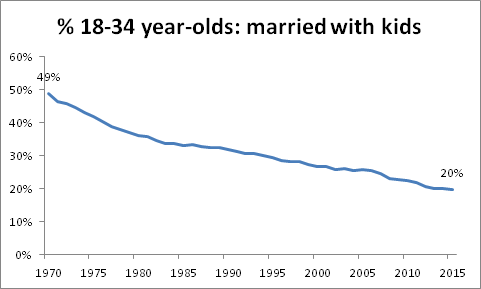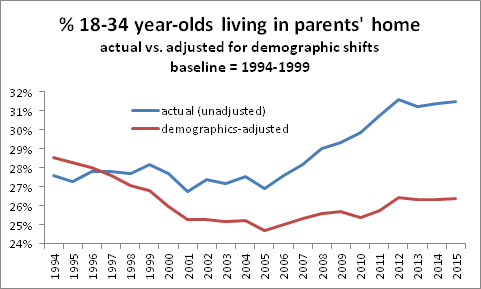The entire increase in young adults living with their parents over the past twenty years can be explained by demographic shifts. That means the high share of millennials living with parents today might be the new normal.
This morning the Census reported that more young adults are living with their parents in 2015 than during the recession. Despite widespread expectations (including my own) that young people would move out as the job market recovered, they are not. The share of 18-34 year-olds living with parents was 31.5% in 2015, up from 31.4% in 2014. (These Census data are from March of each year. See note at end of post on data and methods.) Using different Census data, Pew recently reported that in 2014 the share of young adults living with parents or relatives was at its highest level since 1940 for men and even earlier for women.
The chart below shows the trend. (The charts in this post differ slightly from the newly published Census tables. See note for why.) After dropping a bit from the late 1990s to the early 2000s, the share of 18-34 year-olds living in their parents’ home rose steadily from 2005 to 2012 and has remained near this post-recession high even as the economy has recovered and unemployment for young adults has dropped sharply.
Because the share of young adults living with their parents rose suddenly after the housing bubble of the mid-2000s burst, it’s natural to explain this trend in terms of recent housing and labor market dynamics. After all, young adults with jobs are much less likely to live with their parents than young adults without jobs are. Plus, rising rents and student debt burdens might be holding young people back from moving out of their parents’ homes.
However, alongside recent swings in the housing and job markets, there have been profound long-term demographic shifts that are related to young adults’ living arrangements. For instance, an unusually high share of 18-34 year-olds are at the young end of that range, and younger young adults (18-24) are much more likely to live with parents than older young adults (25-34). An especially important trend is that people are waiting longer today than in the past to get married and have kids — so the share of 18-34 year-olds who are married with kids has plummeted from 49% in 1970 to 36% in 1980, 32% in 1990, 27% in 2000, 22% in 2010, and just 20% in 2015. Unsurprisingly, married young adults and those with children are far less likely to live with their parents than single or childless young adults.
How much have these longer-term demographic shifts contributed to the increase in young adults living with their parents? Using regression analysis, I estimated how much these demographic shifts contributed to changes in young adults living with parents in order to extract the demographics-adjusted trend. I included a standard set of demographic variables: five-year age subgroup, marital status, presence of children, sex, race, ethnicity, nativity (i.e. native- or foreign-born), current school enrollment, and educational attainment.
Adjusted for demographic shifts, the share of young adults living in their parents’ home was actually lower in 2015 than in the pre-bubble years of the late 1990s. In other words, young people today are less likely to live with their parents than young people with the same demographics twenty years ago were. To be sure, even the demographics-adjusted share of young adults living with their parents has climbed back up since the housing bubble burst around 2006, but it remains below pre-bubble levels from the 1990s.
In this kind of analysis it’s important not to explain too much away using demographics, especially if demographic trends might themselves be an effect of living with parents or of the recession. For instance, it’s possible that living with parents might delay marriage: sleeping in your childhood bedroom probably doesn’t help your social life. In fact, though, the decline in young adults being married with kids long pre-dates the recession and the rise in living with parents, and has been relatively steady for decades (see chart above). That means marrying later is not the effect of the post-2005 increase in living with parents.
The other demographic variables we might not want to adjust for are school enrollment (i.e. are you currently in college) or educational attainment (i.e. what’s the highest degree you’ve earned). School enrollment and educational attainment are affected by the economic cycle and affect whether you live with your parents. Plus, the Census counts full-time students in dorms as living with their parents in the data used in this analysis. As a check, I dropped the school enrollment and educational attainment variables and limited the sample to 25-34 year-olds only, few of whom are still in school. The story remains the same: while the demographics-adjusted share of young adults living with parents has increased since the mid-2000s, it remains slightly below the pre-bubble level of the 1990s.
So that’s the punchline: the increase in young adults living with parents over the past twenty years can be explained entirely by demographic changes. The increase since 2005 is not an aberration; once demographics are taken into account, the aberration is the bubble years of the mid-2000s, when an unusually low share of young adults was living with parents.
Adjusting for demographics doesn’t make the recent increase in young adults living with parents — or the implications for today’s housing market — any less “real.” The increased share of young adults living with parents means that household formation is being driven not by millennials but by baby boomers, and helps explain the low share of first-time home-buyers.
But adjusting for demographics does change what we should expect from the future. Because the demographics-adjusted share of young adults living with parents today is similar to pre-bubble levels, long-term demographic shifts may simply have pushed up the share of young adults living with parents to a new normal. Unless demographic trends reverse, the share of young adults living with parents is unlikely to fall much. Today’s millennials will leave their parents’ homes as they age — they’re not going to live there forever. But it won’t be the sudden unleashing of pent-up demand we might have expected if the increase of living with parents were only about the housing bust and recession and not about longer-term demographic shifts.
Notes:
- All original data and charts in this post are based on my analysis of the Current Population Survey’s (CPS) Annual Social and Economic Supplement (ASEC). For 2014, when the ASEC used a split sample, I combined the 5/8 and 3/8 samples and weighted them appropriately. The published Census tables on families and living arrangements, available here, are based on the same underlying data but with minor differences in how living at home or with parents is calculated.
- The pre-bubble years (1994-1999) are the baseline, so the actual and demographics-adjusted shares of young adults living with parents, averaged over those years, are equal by construction. The analysis begins in 1994 because that’s the first year when the complete set of demographic variables is available.
- I downloaded the CPS-ASEC data from IPUMS, which requests to be cited as: Sarah Flood, Miriam King, Steven Ruggles, and J. Robert Warren. Integrated Public Use Microdata Series, Current Population Survey: Version 4.0. [Machine-readable database]. Minneapolis: University of Minnesota, 2015.
- The Pew report cited in the blogpost used data from the American Community Survey and decennial Censuses, which yield different estimates than the CPS-ASEC but the same broad trends.



